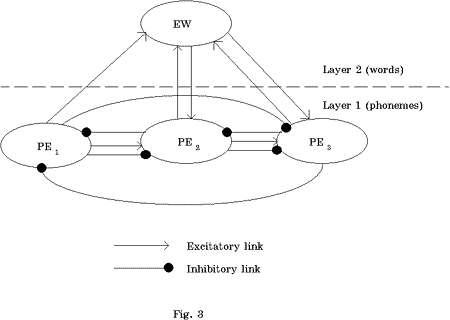5 Active memory
It is well known, that neural networks can realize an
associative memory function. In the neuroenergetic concept a dynamic
associative memory self-organizes as hierarchical structure of neuronal
ensembles of various modalities. The neuronal ensemble is a group of
neurons, interlinked by strong excitatory links and having no
inhibitory links inside, i.e., the ensemble is a MAG with good
conditions for the mutual stimulation of spikes. The first level
ensembles (phoneme ensembles, PE's) correspond to the elements of
alphabets, down to which external situations of various modalities are
being taken apart by automaton's input devices. PE's are an immediate
source of noisy excitation for the whole neural network.
Self-organization of hierarchical associative memory is described in [3] and runs by the following scheme:
1. The neural network in awaking regime needs an optimal
noisy excitation flow. PE, when generating, forms one portion of noisy
flow. For the optimality of noisy flow the continuity of such portions
is necessary.
2. PE's of the same modality prevent each other to work
due to existence of inhibitory links between them. PE, which just has
worked, creates in all others PE's the locked neurons – stoppers. Owing
to the stoppers, PE that receives excitation from the receptor system,
can generate only at LF. To make pauses between HF-generations of PE's
small enough, it is necessary to compensate inhibitory potentials on
the stoppers by means of sending them additional excitatory potentials.
3. The main volume of the learned automaton's memory
consists of ensembles-words (EW's), correlated with objects and
situations in the outer world. EW's are being formed when the phoneme
chains of various modalities work due to objects and situations. Links
between EW and PE's are shown in fig.3.

The main point in such a scheme is an existence of
compensating excitatory links from EW to neurons-stoppers in PE's: by
the moment of excitatory signal arrival at the PE from receptor devices
the compensating potentials on stoppers must already take place. This
statement is in fact the statement of foresight: the automaton guesses
external influences, which are to come in the future; EW, corresponding
to the object, begins to work earlier, than the full influence from the
object will come. In other words, EW is started mainly by means of
associative links from other ensembles, which just have been worked: to
provide the optimal noisy flow, the automaton should work, as a rule,
in the "confirmation of expectation" mode, otherwise it will quickly
fall asleep.
4. EW is an element, having two active states. The first
state (semi-active, S) is the
LF-generation in the exaltation phase. The state S
is easily achievable, stable and very unprofitable: the reserves H are
being exhausted rapidly. We'll call the EW in the state S as the hotbed of excitation (HE). The
second state (active, A) is the
HF-generation in the refractoriness phase. The state A
is a transitory one: due to the fast growth of Ps
the self-locking takes place, i.e., the transition to the rest state R (AÞR).
Active
state A is energetically profitable
because of the rapid decrease of q. When
i-th EW is in the state A (let us
denote this as Ai),
the PE's of i-th word are being started. This creates a good portion of
noisy flow, and in the automaton's memory the i-th object image is
being activated.
5. The function of memory is necessary for memory itself:
when solving the problem of decreasing of q
for memory ensembles, the problem of optimal noisy flow formation is
being solved, and the problem of autonomous behavior appears as a
necessity to find or to construct some external situation, providing
the activation excitation U for Si by the scheme:
Si+U Þ Ai Þ Ri.
Thus, the internal automaton's problem to minimize energy
consumption transforms into the problem to extinguish the hotbeds of
excitation in memory.
6. The group of HE's {Si} in memory is an internal situation in memory, which
represents a concretization of the automaton's wish and compels the
automaton to create an external situation, corresponding to the
internal one, i.e., "extinguishing" it. The process of formation of
HE's is the probabilistic event of transition Ri ÞSi, which depends on excitabilities of EWi.
Excitability of EWi can be increased by means of
the increase of internal EWi links'
conductivities. Such ensembles with increased excitability will be
called the dominants. When EWi achieves the state
Ai,
the conductivities of internal links decrease and EWi
ceases to be the dominant. The dominant can be formed from any EWi, if it stays in the state Si for a long time, that corresponds to the statement
regarding the object i: "underheared", "underlooked", "not understood".
The problem of the automaton's behavior in the external environment is
a reflection of its internal problem to liquidate the dominants in
memory.